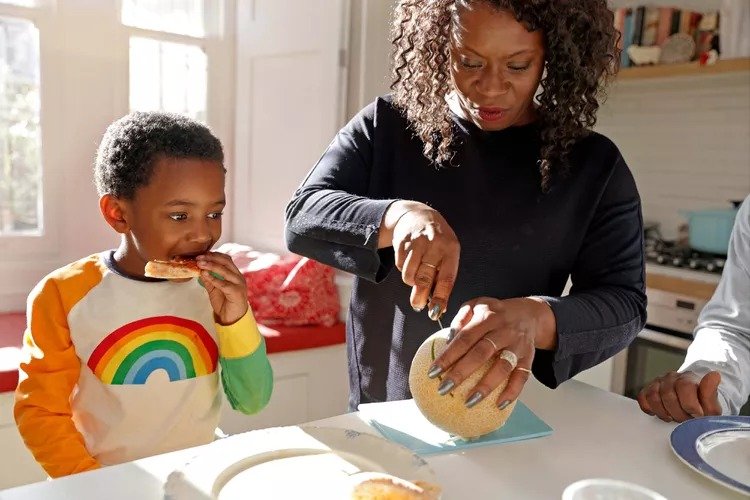13 Nutritionist-Approved Tips for Feeding Kids

Source:https://www.parents.com/
Many parents experience guilt over their children’s diets and often find it challenging to promote healthier eating habits. It’s crucial to help children develop these habits for their growth and overall well-being.
Here are tips to help you guide your kids to eat better:
1. Schedule Meals and Snacks: Children need to eat every three to four hours: three meals, two snacks, and lots of fluids. If you plan for these, your child’s diet will be much more balanced and they’ll be less cranky.
2. Plan Dinner Menus in Advance: If planning a weekly menu feels overwhelming, begin by focusing on just two or three days. A balanced dinner can be simple, including whole grains, a fruit or vegetable, and a protein source like lean meat or beans. Preparing and freezing soups or chili in advance can save time; just heat them up and pair with whole-grain bread and sliced fruit for a complete meal.
3. Make One Meal for the Whole Family: A few years ago, I would cook separate meals for my kids and my husband, which was exhausting. Now, I prepare one meal served family-style, allowing the kids to choose what they want. Since children often mimic their parents’ behavior, I believe they’ll eventually try and eat most of the food I offer them.
4. Don’t Comment on Your Kids’ Eating Habits: As hard as this may be, try not to comment on what or how much your kids are eating. Be as neutral as possible. Remember, you’ve done your job as a parent by serving balanced meals, and your kids are responsible for eating them. If you play food enforcer—saying things like “eat your vegetables”—your child will only resist.
5. Introduce New Foods Slowly: Children often have a natural fear of trying new foods. I explain to my kids that their taste buds may need time to adjust to new flavors. If you’re concerned about your child’s nutrient intake, consider consulting a pediatrician or dietitian for suggestions, such as incorporating a multivitamin or nutrition shake.
6. Make Healthy Food Fun: If your kids won’t eat vegetables, experiment with condiments and dips. Kathleen tried her first vegetable when I served her a thinly cut carrot with some ranch salad dressing.
7. Make Mornings Count: Most families don’t eat enough fiber on a daily basis, and breakfast is an easy place to sneak it in. Look for high-fiber cereals as a quick fix. Or make batches of whole-grain pancake and waffle batter that last all week.
8. Add a Touch of Sweetness: Julia enjoys her cooked carrots with brown sugar, while I mix root beer into her prune juice for a treat. Kathleen and Marty like a sprinkle of sugar on their fruit. Although I know they’ll eventually prefer less sweetness, the important thing is that they are eating their fruits and vegetables for now.
9. Get Your Kids Cooking: If your children become involved in choosing or preparing meals, they’ll be more interested in eating what they’ve created. Take them to the store, and let them choose produce for you. If they’re old enough, allow them to cut up vegetables and mix them into a salad.
10. Think More, Not Less: Remember, you—not your kids—are in charge of the foods that enter the house, so change your focus to adding more nutritious food choices on hand instead of stressing eating less sweets and treats. By having more readily-available healthy choices around, you can encourage your children to eat more fruits, vegetables, whole grains, and dairy products.
11. Allow Treats in Moderation: Occasionally allowing less healthy foods helps prevent them from becoming forbidden, making them less appealing. We refer to treats like candy and cookies as “sometimes” foods. While I typically buy healthy cereals, I let my kids enjoy sugary ones at their grandparents’ or during vacations, and I occasionally treat them to McDonald’s for lunch.
12. Get Creative with Meals: Being creative with meals encourages my kids to try a greater variety of foods. We make smiley-face pancakes and give playful names to items, like calling broccoli “baby trees” or “dinosaur food.” Miniature foods are popular, and I often use cookie cutters to shape toast into fun designs like hearts and stars, which the kids really enjoy.
13. Be a Good Role Model: Parents should model positive attitudes toward food and reflect on their own beliefs about eating. Trusting your body’s hunger cues can teach kids to do the same. Seeking professional help can also aid in developing a healthy relationship with food, especially if one didn’t grow up with good habits. Ultimately, it’s the overall diet over time that matters; occasional treats like popcorn or ice cream are part of a balanced life, as long as they are combined with nutritious choices and physical activity.
Read More: https://childreninfobank.com/safebank/13-nutritionist-approved-tips-for-feeding-kids/
Image Source:https://www.parents.com/





